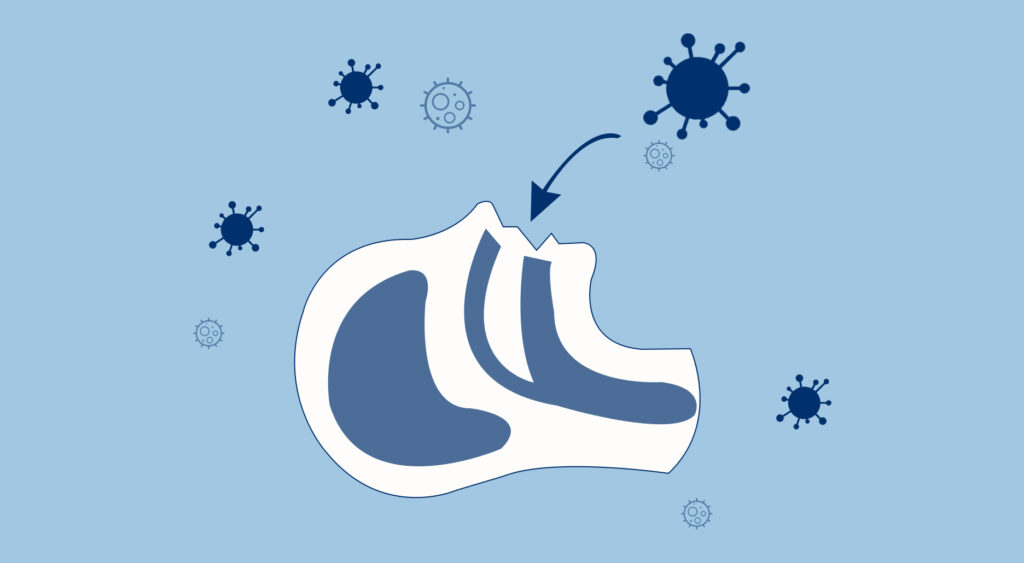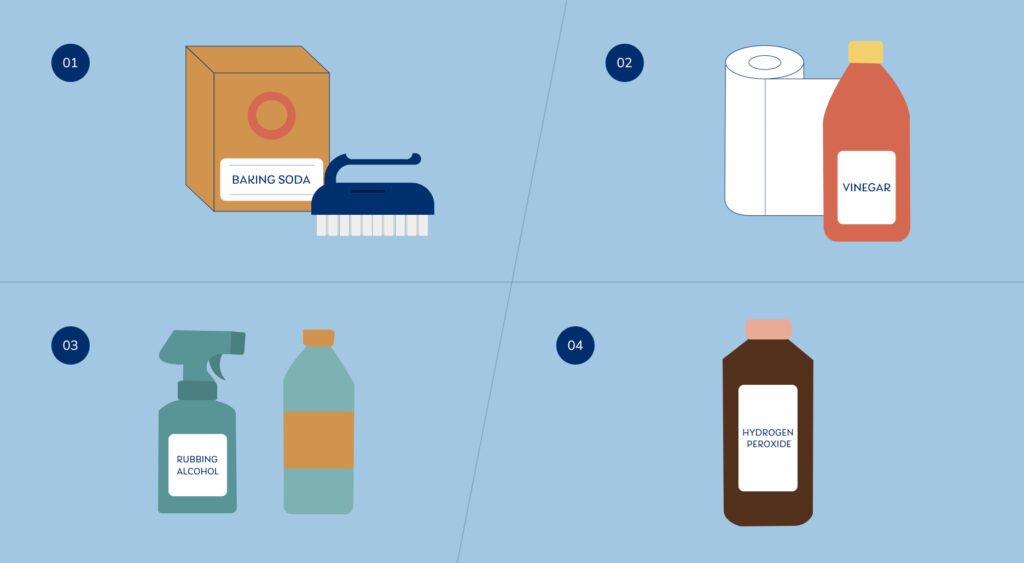Are you considering what you should do if you find mold hiding in the fabric of your mattress? Mold is never fun to deal with, but sleepers can get their mattress looking brand new again with the proper cleaning solutions.
There are many different types of mold, but it's historically known to be quite stubborn. This article will provide instructions on how to get mold out of mattresses, alongside tips and tricks to help prevent mold from growing as time goes on.
Spotting Mold on Your Mattress

Mold can easily be identified by color, usually black, green, or white. It has a fuzzy texture, but this may be less noticeable if it's deeper into the fabric. Other noticeable signs of mold in a mattress include a musty, earthy odor or even concentrated areas of moisture on the surface.
Another consideration is any potential allergy symptoms or respiratory issues that flare up while sleeping in bed but improve when distant from the mattress. This can be tied to mold exposure.
Inspect all sides and layers of the mattress, as mold can grow deep in the materials if moisture seeps in. Mold can develop quickly within 48 hours in ideal conditions. While not guaranteed, excessive moisture increases the risk.
Inspecting Mold on Mattresses
In the best-case scenario, mold will be immediately apparent on the surface of a mattress's fabric. The reality is that mold can be a little tricky to spot, but if sleepers know what to look for, they can be as proactive as possible.
A few common signs a mattress is harboring mold include:
- A noticeably musty odor coming from the fabric
- Odd and sporadic discoloration across the mattress
- Warped surfaces in the construction
- New respiratory health concerns
Mold growth can be damaging in more ways than one, and the earlier it's discovered, the easier it'll be to get rid of. Aside from damaging a mattress, mold can lead to a broad range of health concerns that shouldn't be taken lightly.
Some of these include:
- Difficulty breathing
- Congestion
- Persistent cough
- Skin rashes
- Worsening allergies
It is important to differentiate between mold and mildew, both possible occurrences in mattresses, but do not necessarily develop in the same way.
The Difference Between Mold and Mildew
Most people talk about mold and mildew interchangeably, but they come with some unique differences. Both can be damaging to a mattress and your health. Being able to differentiate the two is the first step before trying to clean a mattress. Thankfully, a few key indicators make it relatively easy to separate the two.
Mold
- Grows into an object, such as the fabrics and materials of a mattress
- Generally appears green or black
- Texture can either be fuzzy or slimy to the touch
Mildew
- A common type of mold
- Generally appears white, grey, or yellow
- Texture can either be fluffy or powdery
- Grows on the surface of an object
Being able to spot mold or mildew is one thing, but it's equally imperative that sleepers understand how mold grows in the first place. Moisture is mold's best friend, but tackling this specific issue can be challenging. Nevertheless, by knowing how mold forms on a mattress, sleepers can be more effective at prevention.
How Does Mold Form on a Mattress?
One of the most common reasons sleepers might find mold on a mattress is due to humidity issues within their home. Depending on the outside climate and construction of the home, getting control of humidity issues can be pretty challenging. In today's world, there are several solutions for this, with dehumidifiers being one of the most popular. If you're able to control the humidity levels within your bedroom, mold won't even have a chance to grow.
Some of the most common causes of mold growth on a mattress include:
- High humidity levels in the bedroom
- Warm sleeping conditions
- Spilling liquids on a mattress
- Excessive sweating
- Improper ventilation under the mattress
Depending on the sleeping arrangement, some of these causes are hard to avoid, but it's crucial to keep an eye out for mold, regardless of the circumstance. In the event mold is found on a mattress, it's time to explore cleaning solutions before the situation gets out of hand.
Remove Mold From a Mattress

Sleepers have a few options to choose from when it comes to removing visible mold from a mattress. Three go-to solutions include using vinegar, rubbing alcohol, or hydrogen peroxide to clean your mattress. Considering how damaging mold can be to your health, always wear gloves, a mask, and eye protection if available. Mold spores can easily spread during cleaning, and keeping yourself protected is best.
Get rid of mold with baking soda
- Before applying the baking soda, vacuum the bed’s surface first, focusing on any visible moldy areas.
- Gently sprinkle 1/2 cup to 1 cup of baking soda directly onto the moldy spots. Use a brush to work it down into the mattress fabric.
- Let the baking soda sit for 24 hours to help absorb moisture and odors while letting its antifungal properties work.
- Once enough time has passed, vacuum the mattress's surface, sides, and seams thoroughly.
- Repeat this process every 2-3 months to help prevent mold growth and odors.
Get rid of mold with vinegar
- Start by removing the bedding and putting it in the wash with detergent and hot water.
- Vacuum the surface of the mattress to grab any lingering mold spores.
- Mix three parts vinegar and one part water in a bottle, coat the affected areas, and let it sit for one hour.
- Use a dry, clean cloth to blot any excess moisture on the surface of the mattress.
- After cleaning the affected area, let the mattress dry in a well-ventilated spot. Ensure that the surface is completely dry before placing the bedding back. For additional protection, use a vacuum to clean the surface once more.
Get rid of mold with rubbing alcohol
- Create a rubbing alcohol solution by mixing a 1:1 ratio of rubbing alcohol (70% concentration) and water in a spray bottle.
- Spray this solution directly on the moldy areas of the mattress.
- Let this solution sit for only 10 to 15 minutes.
- Use a dry cloth or sponge and gently scrub in circular motions to clean the affected area. This helps to avoid damaging the fabric or forcing the mold deeper into the mattress.
- Once the affected area has air-dried thoroughly, use the vacuum on the surface to remove any remaining debris or spores you can't see.
Get rid of mold with hydrogen peroxide
- Use a hydrogen peroxide solution and make sure the room is well-ventilated by opening windows and using fans.
- Wear gloves and spot-test hydrogen peroxide on an inconspicuous area of the mattress first, as it can discolor or bleach some fabrics.
- Mix one part hydrogen peroxide and three parts water.
- Apply this solution to moldy areas and let sit for 10-15 minutes maximum.
- Scrub the area with a clean cloth or sponge.
- Allow the mattress to fully dry before putting sheets and bedding back on.
- Hydrogen peroxide works best on non-porous surfaces, so results on mattress fabric may vary.
Before using hydrogen peroxide to remove mold, be sure to read the product description and follow any dilution instructions carefully. It is important to note that you should not mix hydrogen peroxide with other cleaners or chemicals that produce harmful fumes. Specifically, avoid mixing it with ammonia-containing cleaners, as this can create ammonia fumes that can be dangerous to your health.
Prevent Mold From Growing
There are quite a few prevention methods when it comes to mold. Unfortunately, mold is a part of the natural world, and we all have to battle to some degree. Regarding mattresses and bedrooms, the following prevention methods can be used to mitigate the chance of mold growing in the first place.
A few popular tricks and tips include:
- Adding a hypoallergenic mattress protector to help keep moisture away from the mattress.
- Keep drinks away from the bed to avoid accidental spills and trapping moisture.
- Make sure the bedroom and mattress itself are well-ventilated at all times.
- Regularly check your mattress on all sides, and consider vacuuming the surface on a consistent schedule.
- Avoid stacking mattresses, as this can restrict airflow.
- Consider buying a new mattress about every eight years, as they tend to wear out and get less supportive by then.
- Keep humidity levels low by using a dehumidifier in damp basements or bedrooms to control moisture.
With all these resources, sleepers can guarantee that mold never finds its way into the fabric of their mattress. In the event it does start to grow, there are multiple avenues you can take to kill the mold for good. Catching signs of mold is important, but buying a quality mattress can also be part of the equation.
The Quality Difference With MLILY
While environmental concerns can lead to sparse or aggressive mold growth, owning a quality mattress and mattress protectors can also help fight against it. For example, The PowerCool Sleep System is specifically designed to offer stellar cooling power and ventilation.
The fan-powered adjustable base from MLILY provides fresh air circulation through the various foam layers, guaranteeing a well-ventilated and comfortable sleep experience all night. Sufficient airflow and ventilation also keep the mattress cool and dry, preventing mold growth.
Add an extra layer of protection to your mattress by using an MLILY mattress protector, which offers a range of features to meet individual requirements. For complete protection from all angles, consider the Fully Encased Mattress Protector.
The bottom line
Mold can be challenging to eliminate, but it doesn't have to be the end of the line for the mattress. Between the cleaning and prevention methods mentioned in this article, sleepers are more than equipped to handle moldy mattresses.
It's worth checking out the mattress protectors and high-quality beds available at MLILY, as a good-quality mattress can be the first defense against mold. Knowing how to remove mold from mattresses can save time and money and protect personal health in the long run.
